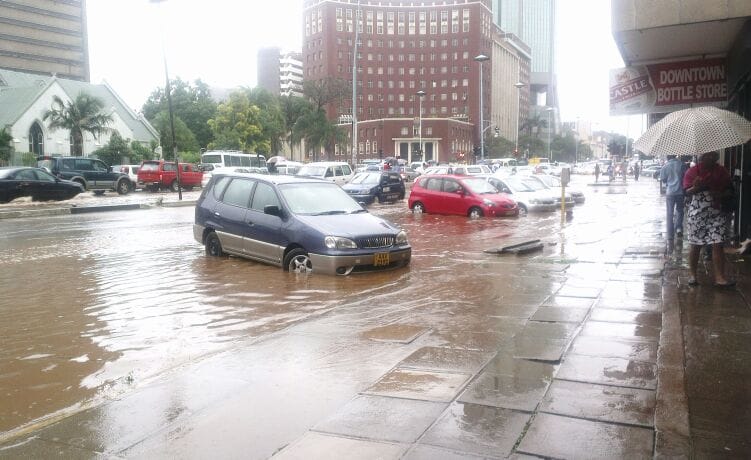Flooding evacuation camps set up in Harare

…as floods flashes away 59 households leaving families stranded
TWO evacuation camps have been set up by Harare City Council and the Civil Protection Unit (CPU) after the latter warned of looming floods in the capital because of incessant rains.
The camps — located at Budiriro 2 Primary School and Kuwadzana 3 Primary School — are meant to provide refuge for residents living in low-lying areas susceptible to floods.

On Thursday, Harare Mayor Councillor Jacob Mafume emphasised the importance of prioritising the safety and well-being of residents.
“We have created two camps with the assistance of the CPU.
“The camps are in Budiriro 2 Primary School and Kuwadzana 3 Primary School …
“There is food that has been provided by the CPU and as a city we have contributed beef through our cattle.
We are Ignite Media Zimbabwe. New members who wish to receive detailed local news from Ignite Media Zimbabwe should “FOLLOW” the link below:
“We will monitor the food situation there and continue to encourage people to move from low-lying areas and to go to these protection centres,” he said.
“The Civil Protection Unit has alerted the City to impending floods due to incessant floods which are going to affect the low-lying areas, in particular Budiriro, Hopley and other areas with people situated in wetlands.”
Fifty-nine households in Harare’s Budiriro 5B Extension and the paddocks area of Kuwadzana have been affected by flash flooding along the Marimba River caused by the ongoing rains, with the river draining most of the western half of Harare.
Of the affected houses, one was extensively damaged in Budiriro while some of the houses are flooded and consequently uninhabitable.
Families have lost food, utensils, blankets, household furniture and clothes due to the flooding.
Most roads leading in and out of Budiriro are covered by water and residents have to plough through water to access their houses. Those residents affected by the heavy flooding have since been moved to evacuation camps for their safety.
The Marimba River is one of the two major tributaries of the Manyame River that drain the major built up area of the city, with the dense urban development meaning that most of the rainfall in its catchment is not absorbed by the ground but runs off, so heavy rain results in large flows and, on the fairly flat land of the lower Marimba, in serious flooding.
The latest disaster comes barely a week after a six-year-old girl was swept away by the angry Marimba River following heavy rains. Her body was retrieved this Tuesday, about 5km downstream from the family home. The body now awaits post-mortem.
Budiriro 5B residents’ representative Mr Pasipanodya Nyamayaro said the body was discovered by someone who was checking on his crops. “The body was already in a state of decomposition and we immediately informed the police and the body was later taken to the mortuary,” he said.
On the continued flooding in the area, Mr Nyamayaro criticised the Harare City Council for failing to address the cause of flooding, which occurs every rainy season.
He called for the allocation of new stands so they build on land that is not susceptible to flooding.
“Moving out of our houses every year as if we don’t pay rates to council is unbearable. Of course, we value the establishment of evacuation centres, but it is time we leave this place. They set up evacuation camps every rainy season since 2017, but we now need long-term solutions to our problems because we are likely going to experience the same challenge next year,” he said.
Mr Nyamayaro said the Harare City Council told them that the problem of flooding could be addressed but they cannot do it owing to lack of resources. Residents have since approached independent engineers to help them out.
Any civil engineering that would allow the regularly flooded land to remain as building land would almost certainly involve the canalisation of the river, that is diverting it into a deep wide ditch that could hold the water without it spreading over the land. This has been done by the city council in the past in several of the older suburbs, the Avondale Stream, a major tributary of the Marimba now flowing in a concrete canal for example, and several sections of the Mukuvisi having been modified by digging.
Modern solutions tend to bar building on land that can be seasonal wetland, rather than draining it, but drainage works have been used in the past to convert wetland into building land.
“We are now appealing to Government to intervene while the City Council can also give us alternative land that is not prone to flooding so that we can resettle,” he said.
Another resident, Mr Method Marunza said they have been trying to set up a good drainage system and roads but they were struggling due to financial challenges.
“As residents, we are appealing for more funds because whatever we are proposing requires funds. We are failing to raise funds and we continue to face the same challenge on a yearly basis. What is more painful is that we are losing precious lives due to something that can be solved,” said Mr Marunza.
Ms Elsie Denga called for the construction of a bigger and wider bridge compared to the existing one, which she said was blocking the flow of water resulting in flooding.
“This bridge can be easily swept away. It is hanging precariously,” said Ms Denga.
In a statement yesterday, Local Government and Public Works Ministry communications director Mr Gabriel Masvora said several houses, household items and access roads were damaged by the flash floods.
He said two evacuation centres at Budiriro 3 Primary School and Kuwadzana 2 Primary School had been identified.
Development partners are being engaged to complement Government’s efforts in addressing the plight of Budiriro and Kuwadzana residents.
Relief in the form of food and non-food items is already being distributed to affected households.
“For Budiriro, 42 households were affected by the flooded Marimba River on Friday 22 December 2023 at around 0200hrs,” said Mr Masvora. The affected households lost their foodstuffs and household property while one house was completely destroyed, 42 households were affected.
“In Kuwadzana, a total of 17 households were affected by floods resulting in the loss of food items, utensils, blankets and household furniture. The households are in urgent need of non-food items (NFIs),” said Mr Masvora.
He said four of the 17 Kuwadzana households have since been evacuated to Kuwadzana 2 Primary School.
Mr Masvora recently said Government had activated all civil protection structures at national and sub-national levels.
Fifty tonnes of maize grain have been set aside for each province while fuel has been availed to conduct rapid assessments and dispatching of relief in the form of food and non-food items to affected communities.







